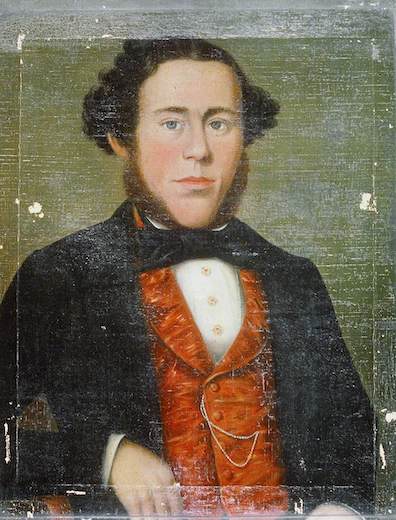Waistcoats of this era usually had five or more buttons that
closed high up on the chest. The sense of propriety inherent
in hiding one's shirt behind all these buttons can be gauged
by Bloom's reaction in Lotus Eaters when he stands up
from his pew in the church and is embarrassed to realize, "Were
those two buttons of my waistcoat open all the time?
Women enjoy it. Never tell you. But we. Excuse, miss, there's
a (whh!) just a (whh!) fluff. Or their skirt behind, placket
unhooked. Glimpses
of the moon. Annoyed if you don't. Why didn't you tell
me before. Still like you better untidy. Good job it wasn't
farther south." The slovenly disinhibition of the bookstore
keeper in Wandering Rocks manifests itself, in part,
in his unbuttoned front: "Onions of his breath came across the
counter out of his ruined mouth. He bent to make a bundle of
the other books, hugged them against his unbuttoned
waistcoat and bore them off behind the dingy curtain."
Like ties, these pieces of sartorial armor must have been
uncomfortable to wear for long periods of time. In Circe
Bloom tries to alleviate Stephen's discomfort in a small way:
"(He bends again and undoes the buttons of Stephen's
waistcoat.) To breathe." At the end of the
day he too is happy to be rid of the "Inhibitory pressure of
collar (size 17) and waistcoat (5 buttons), two articles
of clothing superfluous in the costume of mature males and
inelastic to alterations of mass by expansion." Even
immature males were burdened with such apparel. The Eton suit
of well-off boys' schools included a waistcoat. At the end of
Circe Rudy appears in such a suit and "A white
lambkin peeps out of his waistcoat pocket."
Waistcoats have an obvious utility in the damp and sometimes
chilly British Isles. Earlier in Circe Bloom recalls
that his father owned one that was thermally enhanced: "He
believed in animal heat. A skin of tabby lined his winter
waistcoat." But the practicality of waistcoats was
clearly balanced by their ability to enhance the dullness of
male attire with accents of bright color. In Telemachus
Mulligan dons a "primrose waistcoat," the yellow color
matching his dressinggown and no doubt
confirming Stephen's judgment of him as a "heretic" but also
declaring him a dandy conversant with elegant British customs.
The first illustration here suggests that pale yellow
waistcoats had been fashionable in England since the early
19th century. In Lestrygonians and Wandering Rocks
Tom Rochford is seen in a "claret waistcoat," no doubt
a rich wine-red. In Circe Professor Maginni, the
dancing instructor, appears in "a slate frockcoat with
claret silk lapels, a gorget of cream tulle, a
green lowcut waistcoat, stock collar with white
kerchief, tight lavender trousers, patent pumps and canary
gloves."
In details that perhaps inspired the "Rust black
sleeveless waistcoat, four capacious pockets" of Samuel
Beckett's marvelous Krapp's Last Tape, Bloom's
waistcoat is revealed to be a rabbit's warren of pockets
housing a shifting menagerie of possessions. At the beginning
of Lotus Eaters he takes a pseudonymous calling card
from its hiding place in the headband of his hat and transfers
it "to his waistcoat pocket." Thinking of perfumes and
body odors on the beach in Nausicaa, he performs an
olfactory inspection: "Mr Bloom inserted his nose. Hm. Into
the. Hm. Opening of his waistcoat. Almonds or. No.
Lemons it is. Ah no, that’s the soap." In Ithaca,
having "produced from his waistcoat a folded page of
prospectus (illustrated) entitled Agendath Netaim," he unfolds
it, glances at the ad, and then lights a cone of incense with
it. A few moments later, "He inserted his left hand into the
left lower pocket of his waistcoat and extracted and
replaced a silver coin (1 shilling), placed there (presumably)
on the occasion (17 October 1903) of the interment of Mrs
Emily Sinico, Sydney Parade." In Penelope Molly
remembers how he begged her for a pair of her underwear "to
carry about in his waistcoat pocket." Other men too
appear to use their waistcoats as purses. Professor MacHugh
keeps dental floss in his.
In Proteus Stephen thinks of Mulligan metonymically
as a "primrose doublet," the term reflecting his
interest in Elizabethan times when gentlemen wore short,
tight-fitting padded jackets, either with or without sleeves.
(It seems possible, though beyond my knowledge of fashion,
that the waistcoat evolved from Renaissance doublets.) The
narrative tracks Mulligan's progress through the day by
glancing at his colorful vest. In Scylla and Charybdis,
"Primrosevested he greeted gaily with his doffed
Panama as with a bauble." Dining with Haines in the
D.B.C. in Wandering Rocks, "Buck Mulligan's
primrose waistcoat shook gaily to his laughter." In Oxen
of the Sun he is "the young blood in the primrose
vest," and later in that chapter "the figure of Bannon in
explorer's kit of tweed shorts and salted cowhide brogues
contrasted sharply with the primrose
elegance and townbred manners of Malachi
Roland St John Mulligan."
Rochford, Bloom, and Joseph Nannetti all take advantage of
the opportunity to stick fingers and hands into the garment's
many openings as they contemplate the world and strike poses.
Waistcoats also attract younger hands. In Nausicaa
Bloom remembers the fascination that the row of buttons held
for his young daughter: "Little hand it was: now big. Dearest
Papli. All that the hand says when you touch. Loved to
count my waistcoat buttons."


